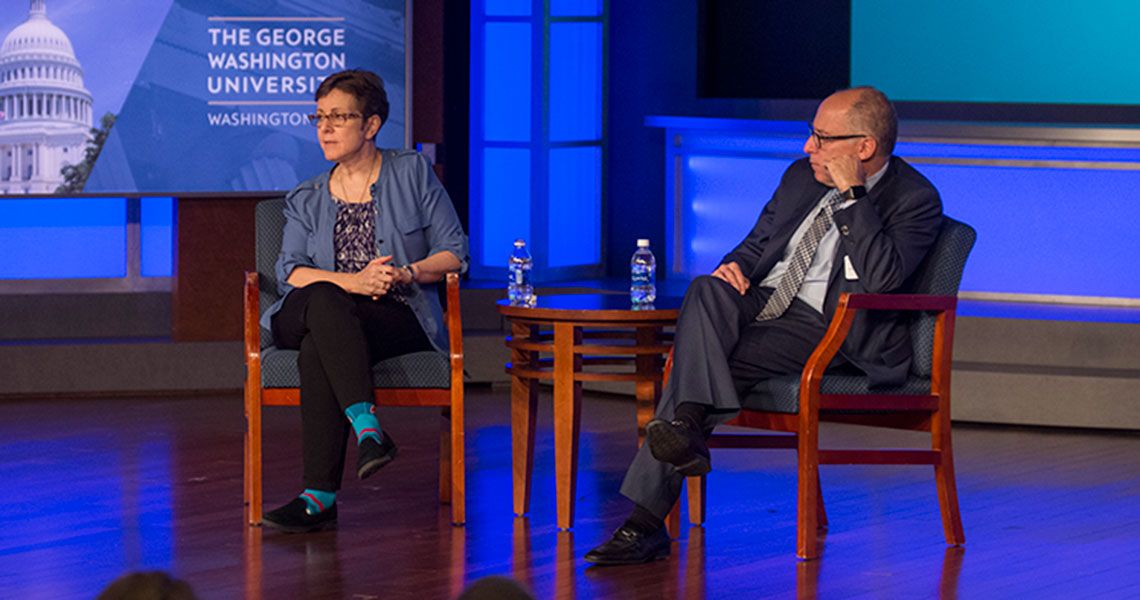Are there any important inventions left? The Wall Street Journal posed this question in a headline three years ago, said Jonathan Reiner, MD, director of cardiac catheterization and professor of medicine at the George Washington University (GW) School of Medicine and Health Sciences (SMHS), to the audience during Frontiers in Medicine: Cardiac Surgery without a Knife.
The article, Reiner told the audience assembled in the Jack Morton Auditorium on GW’s Foggy Bottom campus, lamented what the author identified as “progress slowing to a crawl” following a century of life-changing innovation. Reiner respectfully disagrees.
In his presentation, Reiner focused on the history of cardiac innovation, which he began with a quote from inventor Dean Kamen: “Every once in a while, a new technology, an old problem, and a big idea turn into an innovation.”
It wasn’t until after the Civil War, Reiner explained, that surgeons knew what the heart really looked like when, in 1899, the first surgery on the heart was performed by Ludwig Rehn in Frankfurt, Germany. About half a century later, the first successful operation utilizing a heart-lung machine was executed, and a few decades later stents became popular in cardiac operations.
Reiner’s timeline ended with a present innovation: trans-catheter aortic valve replacement.
Aortic stenosis, the abnormal thickening of the aortic valve causing it to narrow, causing the heart to work harder to eject the same amount of blood that a healthy valve pumps. The trans-catheter aortic valve replacement procedure is the newest method surgeons can use to address the problem without having to perform an invasive operation and exposing patients to risk of infection.
This newer innovation — or as Reiner called it, this “revolution” — involves a catheter that is about five millimeters, or the size of a pencil. “We can do this procedure in about 45 minutes in an awake patient,” Reiner explained. “The system is delivered on a flexible catheter through the femoral artery to the aorta.”
The valve that is delivered during this procedure is fully functioning and will stay in the patient permanently.
“It shows a 75 percent lower mortality rate than surgery,” Reiner said. “It’s not that it’s just as good as surgery, in some cases it appears to be better.”
From a cardiac plumber, as Reiner referred to himself, the second speaker for the evening was a cardiac electrician.
Cynthia Tracy, MD, associate director of the Division of Cardiology, director of electrophysiology, and professor of medicine at SMHS, spoke about the symptoms and newer treatments for atrial fibrillation, or AFib, the most common cardiac arrhythmia.
“One of the major problems associate with AFib is the possibility of strokes,” Tracy explained. “One in four patients who a stroke will have it on the basis of their underlying AFib.”
Patients who have shown symptoms of AFib have been treated with blood thinners.
“The advancements in the blood thinners that are now available has been a tremendous revolution in how we achieve therapeutic anticoagulation,” Tracy said. “Back in the day, the only drug that was available was Coumadin.”
Both Reiner and Tracy, in speaking about aortic stenosis and AFib, pointed out a common thread in these conditions: they are becoming more frequently diagnosed, and some groups have been left out of traditional treatment.
“As the population of the United States gets older, the more cases we see,” said Tracy.
Reiner added that, in terms of aortic stenosis, “only about half of patients get surgery to fix the problem because those who have it are older and have other comorbid conditions that would make surgery complicated.”
In addition, some patients with AFib cannot be prescribed blood thinners if they have an increased risk of bleeding as a result of their health or if they are prone to falling.
However, new innovations promise to help those patients as well. The left atrial appendage occlusion device, an apparatus with a stent-like structure mounted on the end of a catheter, can be placed in the left atrial appendage, where many clots have been found to form, and opened to help prevent clots from dislodging and moving into the heart or elsewhere.
These newer innovations help to ensure that a larger population with heart problems will receive treatment.
The Frontiers in Medicine lecture series is designed to connect members of the Washington, D.C. metropolitan area with health care experts at GW.



